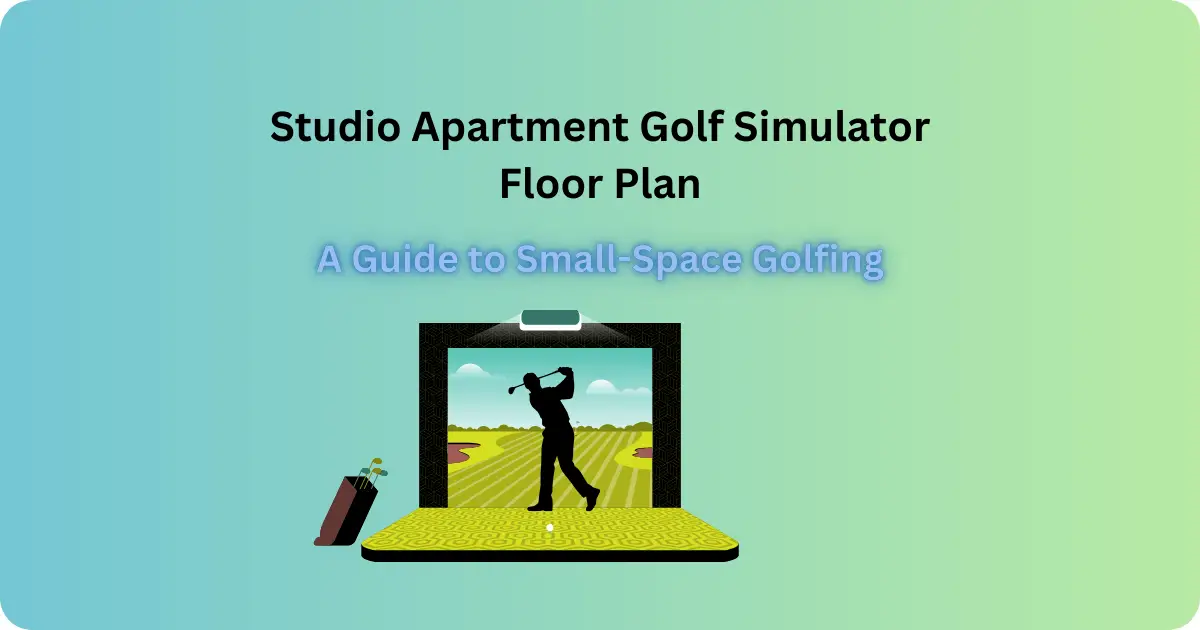Living in a studio apartment doesn’t mean you must give up your golf passion. With some creativity and careful planning, you can design a functional “studio apartment golf simulator floor plan” that fits your lifestyle. A golf simulator lets you practice your swing, improve your skills, and enjoy the game without leaving home. This guide will explain how to set up a golf simulator in a small space and give tips on maximizing your area while staying stylish and practical.
Why Add a Golf Simulator to Your Studio Apartment?
Golf simulators are becoming popular for home use, and even small spaces like studio apartments can accommodate them with the proper setup. Here are some benefits of having a golf simulator in your apartment:
- Practice Anytime: With a simulator at home, you can play golf whenever you want, no matter the weather or time of day.
- Skill Improvement: Simulators provide feedback on your swing, ball contact, and shot accuracy, helping you improve your technique.
- Space Efficiency: A compact simulator setup can transform your studio into a multifunctional living and practice area.
- Entertainment: Golf simulators are great for hosting friends and family and offering fun competitions and games.
- Long-Term Savings: While the initial cost may seem high, owning a simulator saves money compared to visiting golf courses or simulator facilities.
Things to Consider Before Designing Your Floor Plan
Setting up a golf simulator in a studio apartment requires careful planning. Here are some challenges to keep in mind:
- Limited Space: Studio apartments often have tight spaces, so you must measure carefully to ensure the simulator fits.
- Ceiling Height: You’ll need enough height for a full golf swing, typically around 9 feet.
- Noise Control: Hitting golf balls can be noisy, so consider soundproofing to avoid disturbing neighbors.
- Budget: High-quality simulators can be pricey, but smaller spaces have more affordable options.
- Storage: When not in use, you must store golf equipment like mats, nets, and clubs.
How to Create a Studio Apartment Golf Simulator Floor Plan
Designing a golf simulator floor plan for a studio apartment involves innovative space management and selecting the right equipment. Here’s how you can do it:
Measure and Plan Your Space
Start by measuring the available space in your apartment. Ideally, you’ll need an area at least 10 feet wide, 12 feet deep, and 9 feet high. If your apartment is smaller, don’t worry—compact simulators and creative layouts can help.
- Use a corner of your apartment to maximize space.
- Rearrange furniture to create an open area for your setup.
- Opt for a retractable or portable setup you can store when not in use.
Choose the Right Equipment
When space is limited, selecting compact and portable equipment is essential. Here are some options to consider:
- Compact Simulators: Simulators like “SkyTrak” or “OptiShot” 2 are small, affordable, and perfect for studio apartments.
- Retractable Screens and Nets: These can be folded or stored when unused, saving space.
- Short-Throw Projectors: These work well in small spaces and provide a clear image for your simulator.
- Portable Hitting Mats: Choose a mat that can be easily stored to keep your apartment clutter-free.
Make It Multifunctional
Since studio apartments combine living, sleeping, and working spaces, it’s essential to design a golf simulator setup that doesn’t take over the entire room.
- Use your projector and simulator screen for golf and entertainment, like watching movies or playing other games.
- Consider furniture for multiple purposes, such as storage ottomans for golf accessories.
- Add a foldable simulator enclosure that you can hide when not in use.
Focus on Lighting and Ambiance
Good lighting is essential for your golf simulator and your apartment’s overall vibe.
- Use adjustable LED lighting to brighten the simulator area.
- Add soft lighting around your setup to enhance the ambiance without overpowering the room.
Add Storage Solutions
Storage is key in a small apartment. Use these tips to keep your golf equipment organized:
- Install wall-mounted racks for golf clubs.
- Store mats and nets under your bed or in closets.
- Use furniture with built-in storage to hide accessories like balls and cables.
Popular Studio Apartment Golf Simulator Trends
Here are some trends to inspire your setup:
- DIY Simulators: Many golfers build their setups using affordable materials like DIY enclosures and hitting mats.
- Blended Designs: Match your golf simulator to your apartment’s decor for a modern look.
- Multi-Sport Simulators: Some simulators now offer other sports like soccer or baseball, giving you more value for your money.
- Compact Innovations: Newer products, such as ultra-short-throw projectors or collapsible screens, are designed specifically for small spaces.
Conclusion: Designing the Perfect Studio Apartment Golf Simulator Floor Plan
Creating a studio apartment golf simulator floor plan is a rewarding challenge. With the right equipment and design, you can enjoy golf without leaving home, even in a small space. By measuring your area, selecting compact equipment, and incorporating multifunctional designs, you can build a simulator setup that doesn’t overwhelm your apartment.
Remember to maximize your space by focusing on storage, lighting, and noise control. Whether practicing your swing, hosting friends, or simply relaxing with a game, a golf simulator adds fun and value to your home.
With the tips in this guide, you can design a setup that suits your needs and lets you enjoy your love for golf—all from the comfort of your studio apartment.
FAQs
Can I fit a golf simulator in a studio apartment?
With careful planning and compact equipment, a golf simulator can fit in a studio apartment by optimizing the available space.
What equipment do I need for a golf simulator?
You’ll need a compact simulator, a hitting mat, a screen or net, and a projector. Choose portable options to save space.
How much space is required for a golf simulator?
Ideally, a golf simulator setup requires at least 10 feet in width, 12 feet in depth, and 9 feet in height, but smaller setups can work.
What are the benefits of having a golf simulator at home?
A home golf simulator allows for convenient practice, skill improvement, and entertainment while saving money on course fees.
How can I manage noise from a golf simulator in an apartment?
Implementing soundproofing measures and using retractable nets can help minimize noise and maintain good relationships with neighbours.

James Smith is the author of a website called Golf Mentally. He believes that golf is as much about thinking as it is about swinging the club.
Golf Mentally helps golfers of all levels. It teaches new golfers the basics, like how to hold the club and hit the ball. It also helps more experienced golfers learn new things and improve their game.
James wants to help golfers think smart on the course, not just hit the ball hard. He believes that by thinking about your shots and staying positive, you can play much better golf.

